To make the completion of the interior design, during the construction of his own home, special attention should be paid to the design of the flooring in each room. The properties of the material you choose and the quality of the installation of the coating are largely determined by the subsequent comfort in the house. A parquet board is an excellent solution to this issue. Learn all the important features of the floor of the floor from the parquet board, as well as the subtleties of the technology of its installation, you can from this article.
Content
Parquet Board Design Principle
Parquet board is a three-layer product from natural wood. The number of planks in it defines a group of 1, 2 or 3-strip products. Due to the characteristic nuances of the structure, this material features a high level of reliability. Note the most significant features:
- all layers are carefully pricked;
- neighboring fibers in the boards of the finished species are located at right angles;
- for the production of the lower slats, pick up a cheaper version of wood;
- the outer surface is made by certainly expensive species to give high aesthetics.

Important! A wide variety of wood breeds allows you to taste to cover floors from a parquet board - photo of finished projects in a variety of styles will help you make sure that.
Types of parquet board
The decisive factor in the classification of decorative material on groups is structural differences:
- PD-1 - Material made from one layer, the assembly of which is carried out in the squares or rectangles placed perpendicular to each other.
- PD-2 - also features a single-layer base, but the location of the lamellae is carried out longitudinal to the axial line of the board.
- PD-3 is characterized by a two-layer base, while the layers are perpendicular and sampled.

Important! Regardless of which floor under the parquet board you are cooking, carefully refer to the process of choosing a suitable material to ensure the most spectacular attractiveness.
Parquet board sizes
Modern parquet board is largely similar to laminate, but is distinguished by greater strength and naturalness of the appearance. This material is manufactured in the form of a thin long panel.
Parquet Board Parameter Standards:
- the width varies within 14-20 cm;
- length is often determined by 18-24 cm sizes;
- thickness varies depending on the type and manufacturer in the range of 1-2.4 cm.

Important! The quality of the board does not depend on the length or the number of dies. It only expands the borders of the choice for design solutions to emphasize or visually adjust the size of the room. You can easily embody any artistic idea, making the floor from the parquet board, the reviews cause confidence in the correctness of such a decision.
Texture and shades of parquet board
Current manufacturers make a parquet board from all kinds of wood. For each layer, certain options are acceptable:
- for 2 lower layers, different types of conifers are mainly used;
- for upper - decorative, exclusively valuable breeds.
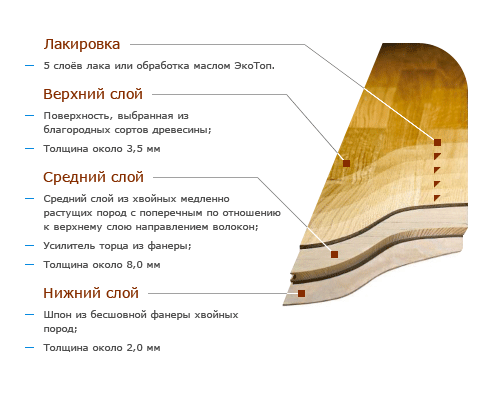
Important! The beauty of natural wood was always highly appreciated by designers and made their work simpler, as all textures create nature itself. The rich variety of shades and textures is due to the fact that the types of wood used are tens of species: from a dark natural oak to a light ash.
Advantages and lack of parquet board
The popularity of this method of flooring is easily explained by a number of advantages, not to note that it is impossible. 
Advantages
- high aesthetics;
- laying work with the board are lighter and faster due to its size;
- absolute environmental friendliness;
- parquet board is resistant to deformation during and after installation;
- not electrified;
- pleasant to the touch;
- absorbs sound.

Important! The service life of such a coating, with proper care reaches 15 years. In addition, among the varieties of this material, different manufacturers have a parquet flooring board for a warm floor - such a popular technology in modern construction.
disadvantages
Despite indisputable advantages, some lack of parquet board are also inherent:
- Poorly withstand external loads, especially mechanical.
- Not moisture resistant.
- Not thermal resistant.
- It is amenable to chemicals.
- Low restoration of the parquet board.
- It is impossible to replace a small section of the floor, in case of damage, since the length of one board reaches 2m.
- It is difficult and spending to lay out the original drawing.
- When removing the upper layer during the cyclove, the appearance immediately deteriorates, as this is not a ground-hay dice, the drawing of which is unchanged.
- A smooth lacquered surface is easily scratched with furniture, but only repair can fix this defect.
- The surface of the coating is sufficiently soft and from heavy furniture on it remains dents and traces.
- High cost of coating.

Important! Remember that the lack of moisture resistance in the parquet board is a serious problem. When moisture gets into the moisture, it swolves, deformed and is not amenable to restoration. Therefore, be sure to purchase only high-quality products, the manufacture of which occurs with a thorough pre-protective processing of wood. 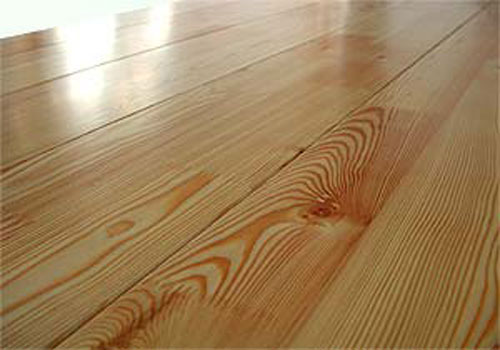
Parquet flooring device
Laying the parquet board consists of three stages:
Paul preparation for parquet board
Usually as a base under the parquet board is used:
- concrete;
- cement strainer;
- old wooden floors;
- lags - long wooden beams.

Important! Given such a wide range of options, it is impossible not to note that you can create an extraordinarily beautiful floor from a parquet board on any surface of the base.
To prepare the floor under the laying of a parquet board, do the following:
- Carefully clean the surface.
- Align the cement tie or form the bulk floor under the parquet board.

- Check the solidity of the coating using the construction level.
- Dry the surface.
Important! The maximum permissible error in height is not more than 2 mm per 1 square meter of the floor.
- Once again, cleaned the created coating, but more sprinkling in order to achieve the desired result - dry, purified from dirt and dust surfaces.

Mounting Rules Substrate
The substrate implies a waterproofing material, the thickness of which depends on the parquet board. To create it, use the following materials:
- waterproofing film with a density of 200 microns;
- hydrooparizolytor;
- heat insulator foamed polyethylene;
- moisture resistant plywood;
- polystyrene foam.

Important! Type of suitable material Choose based on the features of the project flooring device and its financial capabilities.
Consistently install the substrate, observing the following rules:
- Place the waterproofing film on the screed.

- Film staps with clips by sight on each other, focusing on standard recommendations in 20 cm.
- On the perimeter of the room, wrap the wall on the wall by 5-6 cm.
- Locate the heat insulator to the next layer.
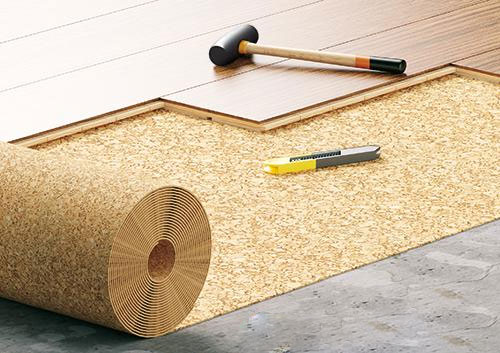
Important! Foamed polyethylene is quite enough for the floor to be well insulated, and also missed the minimum number of noise. If necessary, enhance the thermal insulation of this surface, use polystyrene plates. Such material is placed close to the walls without gaps between sheets. - Crerate stripes of foam polyethylene scotch.

Important! If the base was made of concrete, instead of waterproofing material as a substrate, use Paneur. Stick it with parquet glue by screwing the screws.
Technology laying
Initially, determine the laying method, which is more acceptable in your case. In this regard, take into account the venue of the room and the selected pattern of the coating. 
Important! Be sure to keep in mind that between the wall and the board it is necessary to leave the gap of 8-12 mm. This gap will provide the possibility of expanding the board in the case of high humidity.
Next, start stacking the floor and parquet board as follows:
- Put the first board in the corner to the wall.
- Insert the wedges with a thickness of 7-8 mm between the wall and the board.
- Put the subsequent boards along the wall, not forgetting about the gap.
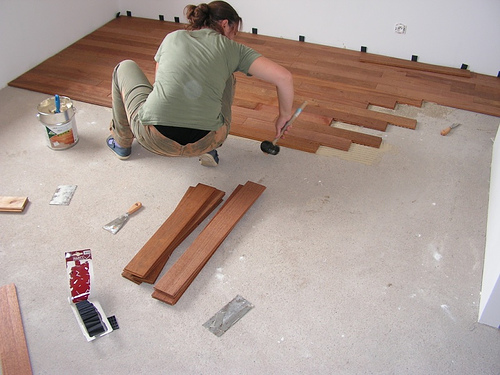
Important! Be sure to leave the gap, in order to avoid the deformation of the floor from a minor expansion during the temperature differences and air humidity. - Attach one board at the end of the wall and mark the cut line.
- New row Start from the cut part of the board.
- Apply the boards by the lock to the previous row at an angle of 25 degrees.
- So that the locks of the castle agrees, carefully push down and forward at the same time.
- Come on the line connection of the Rubber Cyans boards until the boards take the right position.

- Put the subsequent boards in the same way.
- At the end of the assembly, remove the wedges.
- Cut the edge of the oilbox, which was previously bent on the wall.
- Set the perimeter of the plinth strictly to the wall.

Important! If you need to adhere to a specific ornament - cut off excess from the remnants to combine the pattern.
Video
Look at the proposals in detail an example of a video installation of wood flooring.
Ways installing floorboards
The laying of the parquet board occurs fairly quickly and easily due to the large size of the board. 
There are several methods of laying boards:
Floating method
This floor mounting method is made without glue, with the help of the proper compound of the groove and spike. Boards are not fixed to the base.
Such a connection has several advantages when comparing with adhesive:
- over time, when exposed to temperature and moisture, the attachments are not weakened;
- less time costs;
- if necessary, it is easily dismantled.

Method of sticking on the basis
The gluing method is used in the case when the area of \u200b\u200bthe room where the floor laying will be made significant and high rigidity is required.
Important! The prerequisite for this method is the perfectly even and clear surface of the floor. 
Laying parquet board on wooden floor
For high-quality laying of the board on the old floor, it is necessary to prepare it in a certain way.
In addition, there are several distinguishing recommendations on the maintenance of a parquet board:
- Clean the surface.
- Align the grinding machine tree.
- Old boards pick up and pon the place.
- Place the waterproofing film.
- Parquet board lay across the main one.
- Secure them through the ridges with nails.
- Apply glue over the entire length of the board on the grooves and crests.
- For the strength of the laid floor, glue the panels among themselves.

Laying parquet board on lags
Lags are long rectangular wooden bars 5.5 * 10 or 5.5 * 15 cm.
To form a coverage from a parquet board for this technology, do the following:
- Secure the lags to the base.
- Use to secure the self-tapping screw, withstanding the distance not more than 40 cm from each other.
- Align all lags under one level using a planer.
- Lay on it a waterproofing film.
- In a checkerboard, cover the film by moisture-resistant plywood.

- Secure the phaneer with self-drawing and polish the joints.

- Use 2.2-2.5 cm thickness material.
- Cover the floor of parquet items perpendicular to lagas.
- Stretch the boards with adhesive or floating method.

Parquet board on a warm floor
If you are planning to laying a parquet board on a heated base, consider these nuances:
- suitable panel thickness - 1.3-1.5 cm;
- be sure to use the waterproofing layer;
- with the arrangement of the warm floor system, the heat should be distributed evenly;
- control the air temperature above the floor so that it does not exceed 27 degrees.

Important! The thickness of the board in 2 cm and above reduces heat transfer, and this increases energy consumption for the heating of the floor.
Installation of a parquet board diagonally
This type of laying looks more original and brings originality in the interior of the room.
But this method has a few minuses:
- more complicated in performance;
- requires high accuracy of the subgone and the perfect trimming of the material;
- more expensive;
- it is impossible to make laying on the lags.

Among the distinguishing recommendations on the installation technology, we note the following:
- The direction of panels, as a rule, has an angle of 30-40 degrees relative to the wall.
- Blesh the panels with each other with glue.
- Solutions apply around the entire perimeter of the board.
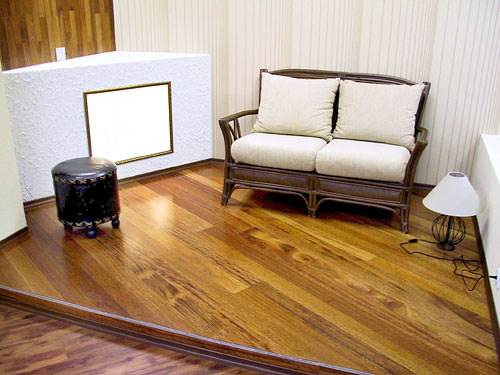
Repair of floors from parquet board
Repair of coating from such material will be needed in such cases:
- Drawing boards. Fit this defect quickly and with minor costs is permissible only when the laying was performed by a floating method - simply dismantle the panels and re-collect them.

- The appearance of the gaps and elevation between the panels. To remove such a flaw, make such actions:
- Parquet coating swelling. Unfortunately, the boards will have to be replaced. If the adhesive method was used, the entire coating will be required.

- Scratches and potholes. Depending on the scale of damage to the coating, the technique of its elimination will be varied:
- The need for general floor restoration due to coating wear. This version of the repair work is the most labor-intensive and will require you a much larger amount of free time. The sequence of floor restoration steps from a parquet board is as follows:
- treat the surface of the squad machine;
- mix the solution of putty with wood sawdust;
- get all the potholes and other irregularities obtained by the mixture;
- collect the boards;
- apply primer;
- make a technical break until the mixture is completely drying;
Conclusion
To provide a long-term preservation of the attractiveness of the formed flooring, be sure to follow the recommendations regarding the care of the parquet:
- Clean the floor from a parquet board slightly damp cloth. Remember that the surface of the floor from such material is extremely not taking moisture.
- Use the brush nozzle designed specifically for the treatment of wooden lacquered surfaces when cleaning the floor with a vacuum cleaner.
- Stick on the legs of furniture soft lining. This will help keep your new floor in perfect condition without scratches and dents.








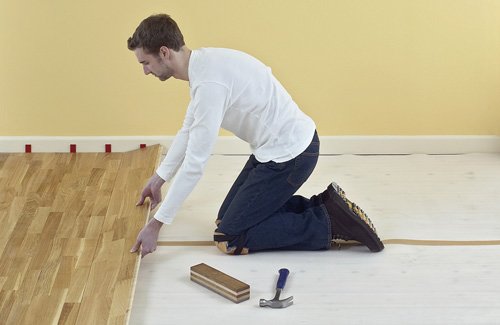


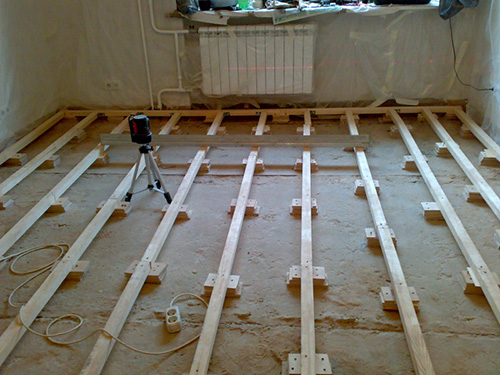
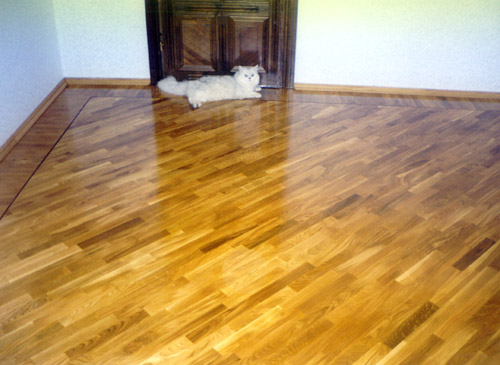





















If you need to disassemble a concrete screed, I recommend using the services: https: //xn--80ahqp0afz7a3a.xn--p1ai/demontazh-i-snos/demontazh-betonnoj-styazhki/ - Professionals of their business
Agree, dachali.rf. - Best!